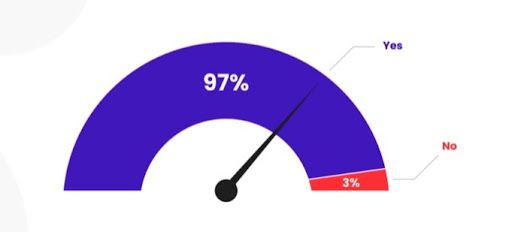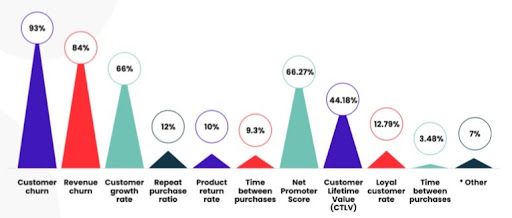Tracking retention and measuring churn on a regular basis is vital for a SaaS business to succeed.
The financial benefit of repeat custom is huge, and if you’re a regular reader here, you’ll know I’m about to trot out my favorite statistic… yep! It costs five times more to gain a new customer than it does to retain a current one.
But how do successful SaaS organizations measure retention and what on earth do they with the results, I hear you cry?
Well, we surveyed 100 SaaS pros to find out how they track, review and utilize retention and churn metrics, and here are the results.
We started by asking whether their company tracks retention, and to our relief, a resounding 97% answered yes.

Next up, we wanted to know how often they review them.
How often do SaaS organizations review their customer retention metrics?
Any SaaS organization worth its salt is keeping a close eye on its retention metrics, although Google would have you believe that annually is frequently enough.
The results here were a bit of a mixed bag, with 38.37% of our respondents tracking weekly, 32.55% reviewing monthly, and 12.79% checking daily.

What kind of metrics are they tracking?
Customer retention metrics are a critical part of planning long-term business strategies, but which metrics are most important to our SaaS practitioners?
A unanimous 93% answered customer churn, while 84% looked to revenue churn to paint them a financial picture.

How do they make those metrics actionable?
Last but not least, we asked our respondents, ‘once you have this information, what do you plan to do with it to make it actionable?’ Here’s what they had to say.
“Identify areas of risk and opportunity and apply the appropriate mitigation or optimization plans against them.” - Sirous Wadia, Practice Director, Customer Success at K1 Investment Management
“We review for trends first and then for details on an individual basis. We make training and enablement decisions based on gaps that we might identify, and we use the data to influence product development.” - Patrick Kelly, Senior Director of Customer Care Enablement & Operations at Brainshark
“Understanding the data behind the metric is more my style. The number itself is not as important. I look at a lot of the why's and when in the journey things happened.” - Star Hofer, Vice President of Customer Success at PartnerStack
“If your metrics are hard to decipher, you're less likely to get anyone's interest. You have to tell the story of the numbers...and in many cases, tell them what they are supposed to walk away from your engagement knowing.

“I like to structure this information in a slide (one for each metric). Within that slide, there will be a chart of some kind (for this example, we'll use customer retention). 1/2 of my slide will be a historical graph of that metric, so people can understand if we're getting better or worse over time. “The other 1/2 is structured with 4 basic parts.
1. What's Important
2. How is it going?
3. Plans to Improve/What's Next
4. Where I need help
“I've found that structure resonates with the front line to the boardroom in terms of telling the story of the metrics.” - Christopher Brown, Director of Success at Fulcrum
“Develop a plan to understand, from the customers who did churn, why they did. Based on that feedback, we will then strategize how we can mitigate the risk of others having that experience or issue as well.” - Samantha Czulada, Customer Success Manager at Northpass
“We aim to understand macro trends and specific account-level lessons learned.” - Richard Rans, Senior Director of Customer Success at Terminus
“Modify existing processes to allow GTM teams to leverage data for further strategic discussions.” - Josh Zamora, Director of Customer Success Advocacy at ServiceNow
“Establish benchmarks and performance OKRs to drive improvements across CS organization.” - William Kahn, VP of Customer Success - Americas at Centrical
“Salesforce reports with next action in our Success Plan. Review SWOT's and GOAL's to make sure they are aligned.” - Nathalie Rierson, Customer Success Manager at Magnitude Software, Inc
“Tie to concrete OKRs and actionability with Marketing, Operations and Field teams.” - Roberto Croci, Managing Director at Microsoft for Startups MEA
As you can see, tying metrics to actionable OKRs is a popular and practical answer. After all, without clear goals and strategies, metrics are just numbers - and make no mistake, having a good retention strategy in place is vital for the health of your business.
Remember, retaining customers is much cheaper than acquiring new ones and goes a long way in building meaningful customer relationships that pay off in ways that benefit your brand, reputation, and bottom line.
Would you like to sink your teeth into some more juicy retention stats?
How about some actionable tips and recommendations on tools to manage churn?
Download The State of Customer Retention Report, 2021
You won’t regret it.



